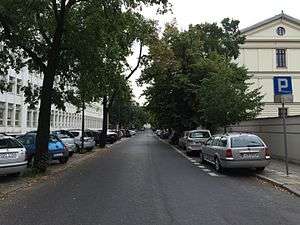Father Stanisław Konarski Street in Bydgoszcz
| Bydgoszcz | |
|---|---|
| <span class="nickname" ">Polish: Ulica Księdza Stanisława Konarskiego | |
|
Northward view of Stanisław Konarski street | |
|
Location of Stanisław Konarski street | |
| Former name(s) | Schule straße |
| Namesake | Stanisław Konarski |
| Owner | City of Bydgoszcz |
| Length |
290 m (950 ft) Google maps |
| Area | Downtown district |
| Location | Bydgoszcz |
| Construction | |
| Construction start | End of the 1870s[1][2] |
| Completion | 1880[1] |
| Wikimedia Commons has media related to Father Stanisław Konarski Street in Bydgoszcz. |
Stanisław Konarski street is a historical street of downtown Bydgoszcz.
Location
Father Stanisław Konarski Street follows a roughly north-south axis, from Piotra Skargi Street to Jagiellońska street. It runs parallel to the eastern edge of Casimir the Great Park.
History
While the main downtown (Polish: Śródmieście) thoroughfare of Bydgoszcz, Gdańska Street, had a brisk expansion after 1830s, collateral areas (Piotra Skargi Street, Kołłątaja street, Gimnazjalna, Libelta or Szwalbego Streets) developed at a more slower pace.
First reference of Father Stanisław Konarski Street in city address book of Bromberg dates back to mid-1870s.[1]
First map to mention the street bears the year 1876.[2]
Through history, the street bore the following names:
- 1870s-1920, Schule straße (School street);[1]
- 1920-1940, Father Stanisław Konarski street;[3]
- 1940-1945, Schule straße;[4]
- Since 1945, Father Stanisław Konarski street.
Actual namesake comes from Stanisław Konarski (1700–1773), a Polish pedagogue, educational reformer, political writer, poet, dramatist, Piarist priest and precursor of the Enlightenment in the Polish–Lithuanian Commonwealth.
Main edifices
Regional Office Buildings, at N°1-3, corner with Jagiellońska street N°7
1962-1965 (building on Konarski street), by architect Jerzy Jerka, 1966-1969 (tower building), by architect Bronislaw Jablonki[5]
Both buildings, (14-storey tower and the long one on Konarski Street) are additions to the 19th century original edifice, where now seats the Kuyavian-Pomeranian Voivodeship administration and leadership. They are connected to the historical house via a pedestrian covered bridge, crossing over an entry to the Casimir the Great Park.
-

View from Jagiellońska street
-

View from Konarski Street
-
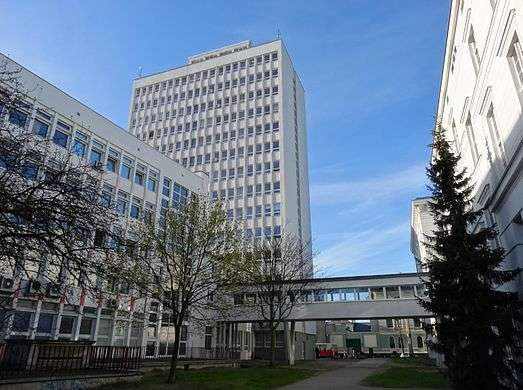
The tower at N°1, an extension at N°3 (left), the pedestrian bridge, and the historical building (right)
Tenement at Jagiellońska street N°9, corner with Konarskiego Street
1872
The building was erected in 1872 on a design by architect Müller, so as to house the civic school for boys (German: Bürgerschule).[6] The school was initially located in the former Bydgoszcz's Carmelites monastery. It was an elite folk school, with a 9 years cycle, and pupils usually belonged to wealthy high society, rich enough to pay the high tuition fees.[7] In the mid-1880s, the Bürgerschule moved further up in Konarskiego street, where is located today the Bydgoszcz School of Fine Arts (N°2),[8] or, according to the Prussian street numeration, from N°8 to N°7.In the 1990s, the edifice housed the Foreign Language Teacher Training College, which then moved to Dworcowa Street. Since 2010, the seat of the Kujawsko-Pomorskie Centre for Education and Kuyavian-Pomeranian Voivodeship Marshal's Office in Bydgoszcz are located here.
The building boasts historicism features, with a predominant Neoclassical architecture form. It has a "L" shape, with a prominent avant-corps in the middle of its frontage, with two storey, an attic and a basement. The entrance double portal is topped with a triangular pediment and a tympanum in which is placed a circular ornament. The facade is divided by horizontal cornices and a wide frieze on its top. The ground floor is decorated with bossage.[9]
-

The building ca. 1915
-
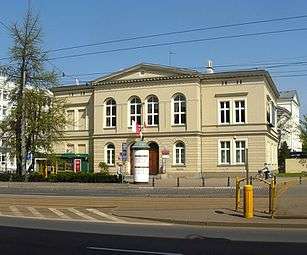
Today, view from Jagiellońska street
-
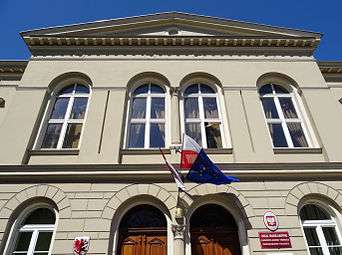
The avant-corps and its pediment
Bydgoszcz School of Fine Arts, at N°2
Kuyavian-Pomeranian Heritage list N° A/743 & 158/A, 11 April.[10]
1875-1878, by Heinrich Gruder & Carl Rose
The school building has been designed by engineer Heinrich Gruder[11] who worked on the construction of nearby St Peter's and St Paul's Church, and executed by city architect Carl Rose,[12] who realized several other edifices in Bydgoszcz, particularly in Gdańska Street. Once completed in 1878, the building housed the Town School for girls (German: Städtische Töchterschule), having its address at SchulStraße N°7.[6] In 1885, the School for girls swapped its location with the one for boys (Bürgerschule), between old N°7 and 8: girls moved to nowadays house at the corner with Jagiellońska street, boys to the present building at Konarskiego N°2.[13] The school for boys operated there till 1911, when it moved again to actual Staszica street. From 1920 to 1935, the edifice housed the Faculty for boys, Polish: Męska Szkoła Wydziałowa dla Chłopców. Having accommodated a military hospital at the end of World War II, the building resumed its initial role in 1982, when the Bydgoszcz School of Fine Arts (established 1945) moved from Pomeranian Arts House to the precincts.[14] The edifice has undergone its last renovation in 2011, with a co-funding between European Regional Development and Polish State.
The building was built in the style of eclectic with a predominance of Neo-Renaissance elements. It has two-storey, with a high basement.[12] The facade, in its central part displays a large avant-corps, topped by a pediment. The first floor is adorned with pilasters flanking lancet windows, the ground floor has a bossage decoration: on the elevation, floral friezes are visible. Both building wings are covered with gable roofs.[12] Inside, one can notice the main staircase, adorned with a wrought-iron balustrade with floral motifs. The main hall is ornamented with Tuscan pilasters and ionic order columns. On the second floor, the auditorium is garnished with a magnificent contemporary stucco work.[14]
-
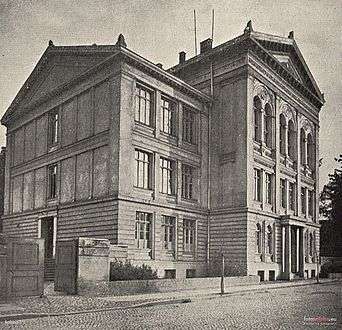
Building ca 1937
-

General view of the elevation
-
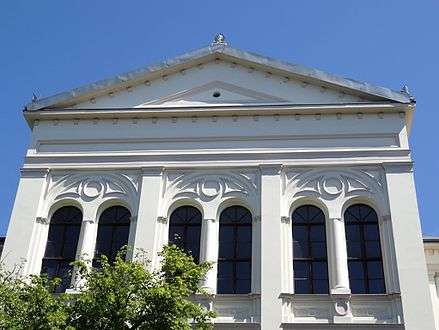
Detail of the avant-corps
-

Main gate
-

Backyard view
Building of the Catering School of Bydgoszcz, at N°5
1882-1884, by Wilhelm Lincke[9]
The building was designed to fit a High School for girls (German: Höhere Mädchenschule), established May 1853. Despite the high tuition fee, the edifice was too large and exceeded the needs.[15] Hence, the school was split in 1909-1911 into an urban high school, a four-year teachers' college and a two-year school for educators nurseries and kindergartens (German: Frauenschule). In these schools, most of the students were from German origin.[15] In 1920, the building housed the Faculty for girls, as men's one was located in the same street at N°2. In 1928, this girls institution received the patron name of Maria Konopnicka. Despite its success (719 pupils in 1925), the 1932 new education system put an end to the university: in 1935, the facility was combined with men's high school and moved to a building at Chwytowo street 16.[16] During World War II, the building was converted to a field hospital.[17]
In 1946, Public School No. 6 was located there.[18] In 1952, the building housed a vocational school for clothing and catering. In 1978, the name changed to the "School of Clothing and Cuisine in Bydgoszcz" (Polish: Zespół Szkół Gastronomicznych i Odzieżowych w Bydgoszczy), converted in 1984 into the Catering School. It comprised the following departments: Gastronomic Vocational School, Technical Gastronomy, Catering for Technical Workers.[19] In 1990, the school opened new secondary vocational curriculum. In September 2006, a new building was opened, after 78 years without extension. In March 2011, the school received the ISO 9001 certificate.[19]
The original building has two-storey, a basement, and is covered with a low hip roof. The block possesses small wings, and displays three avant-corps on the street. The plastered brick facade is decorated with friezes. Each level is separated by cornices and wide geometric patterns. Each avant-corps is topped by a prominent gable, supported by corbels. Windows are semicircular, and the main door is adorned with a high brick portal.[9] The 2006 addition is located in the backyard, giving onto Casimir the Great Park.
-

Building ca 1901
-
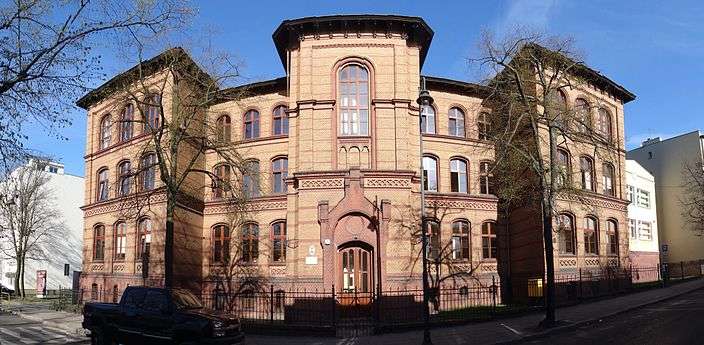
Main elevation on Konarskiego street
-
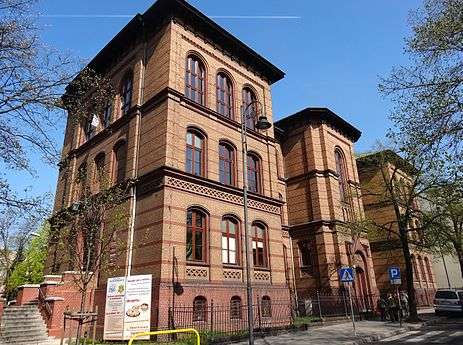
One of the three avant-corps
-
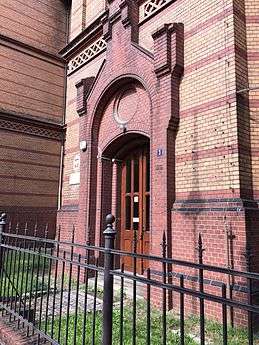
Main entry gate
Gymnasium at N°4
ca 1878[20]
Since its inception, the building has been used as a sports hall (German: Turnhalle) for the different schools in the street. It is still used today as such by the Catering School of Bydgoszcz.[21]
Despite being a simple gym hall, the building, nonetheless, exposes nice architectural details such as large round top windows on street facade flanked by pilasters, a portal framing the main entry and carved wooden beams adorning the bottom of the gable.
-
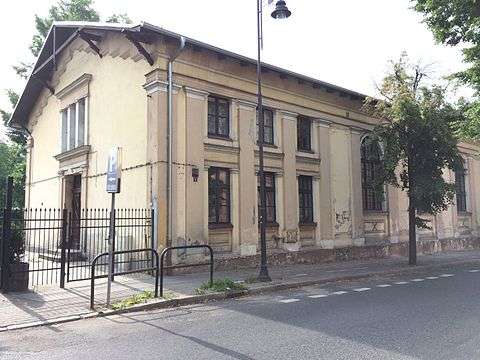
Sports hall from the street
-

Main entry
-
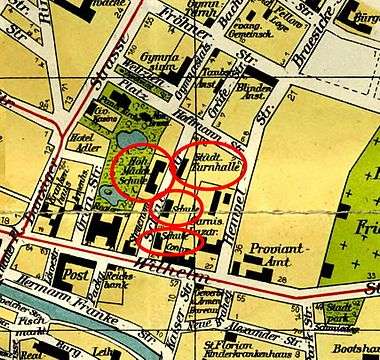
The sports hall (Turnhalle) and surrounding schools on a 1914 map of Bromberg
Tenement at N°6
ca 1950-1960s
This recent building from the second half of the 20th century, is a perfect illustration of functionalism style. It boasts two avant-corps on its edges. In this regard, it recalls early modern architecture tenement at Plac wolnosci 7 or others in Gdańska Street (N°23 & 188 for instance).
-
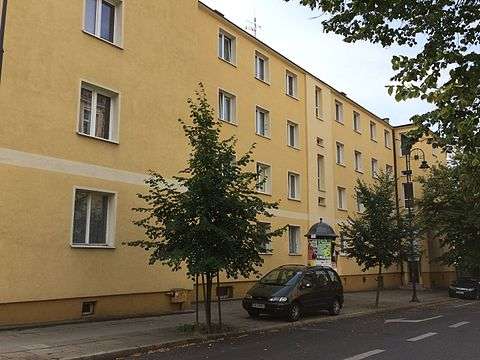
View from the street
Tenement at N°7
1880s[20]
Initially Schule straße 2, it was owned by Albert Giese, who never lived in. The building was designed as a tenement house with flats for rent. In 1900, Richard Lampe, a physician living at Gdanska street N°35, bought the tenement: as a surgeon, specialized in women's diseases, he opened a clinic in the building.[22]
The tenement displays Neo-Renaissance features. Each second level window of the facade is flanked with minutely designed pilasters and topped with pediment. Likewise, the main entry gate has pilasters on its sides, adorned with floral motifs.
-

Main elevation on the street
-
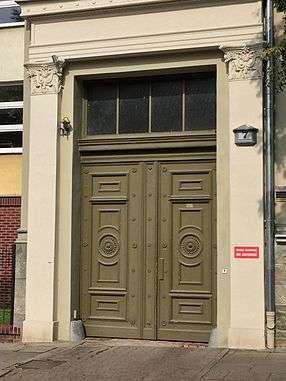
Main gate
-

Architectural details of the facade
Hotel "Bohema", at N°9
Kuyavian-Pomeranian Heritage list N° A/1385, 16 September 2008[10]
1877, by Anton Hoffman
Originally designed as a complex of renting flats, the building became in 2008 a 5-star rated hotel, "Bohema Hotel".
-

Main elevation on the street
-

By night
Tenement at N°11
1907[23]
Referenced initially as Schulstraße 4/5, the building was conceived as a tenement house for flat renting. His first landlord was a dentist, Sallh Jacobowski, living at Danzigerstraße 165a (now Gdańska Street N°10).[24] It then became the property of various rentiers, and accommodated an average of 15 tenants till the oubreak of World War II. Anecdotal detail, a dentist practitioner is installed today in this building.
The edifice features a mix of eclecticism (wooden loggias and balconies, neo-classical motifs) and Art Nouveau (round shapes, curved entry gate, ogee gables) style and details. One can notice, among others:
- wooden balconies and loggias on the park facade and in the backyard;
- a bartizan wedged on the elevation giving onto the park;
- the main wood door, topped by a transom light, and enclosed in an ogee portal.
-

Main elevation on the street
-
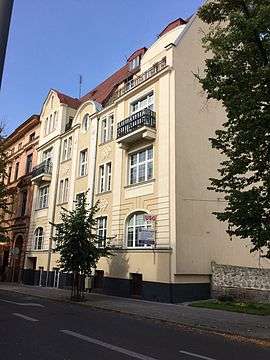
View from intersection with Piotra Skargi Street
-

Backyard details
-
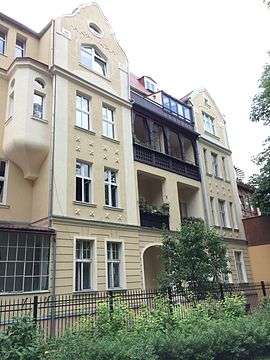
Facade on the park
See also
- Bydgoszcz
- Piotra Skargi Street in Bydgoszcz
- Gdańska Street, Bydgoszcz
- Freedom Square, Bydgoszcz
- Jagiellońska street in Bydgoszcz
- Casimir the Great Park
External links
- Kuyavian-Pomeranian Voivodeship office in Bydgoszcz
- Fine Arts School of Bydgoszcz
- Catering School of Bydgoszcz
- Hotel Bohema
Bibliography
- (Polish) Umiński Janusz: Bydgoszcz. Przewodnik. Regionalny Oddział PTTK „Szlak Brdy”, Bydgoszcz 1996.
- (Polish) Parucka, Krystyna (2008). Zabytki Bydgoszczy – minikatalog. Bydgoszcz: "Tifen" Krystyna Parucka.
References
- 1 2 3 4 Adressbuch nebst allgemeinem Geschäfts-Anzeiger von, Bromberg und dessen Vororten auf das Jahr (1878). "Schulen". auf Grund amtlicher und privater Unterlagen. p. XXXXVII.
- 1 2 1876 Plan der Stadt Bromberg
- ↑ Plan Miasta Bydgoszczy, 1933
- ↑ Stadt Bauamt, Bromberg, 10 VII 1941
- ↑ Umiński, Janusz (1996). Bydgoszcz. Przewodnik. Bydgoszcz: Regionalny Oddział PTTK "Szlak Brdy". p. 102.
- 1 2 Adressbuch nebst allgemeinem Geschäfts-Anzeiger von, Bromberg und dessen Vororten auf das Jahr (1880). "Strassen". auf Grund amtlicher und privater Unterlagen. p. XXXXIII.
- ↑ Biskup, Marian. Historia Bydgoszczy. Tom I. Do roku 1920. Bydgoszcz: Państwowe Wydawnictwo Naukowe Warszawa-Poznań 1991. p. 588. ISBN 83-01-06666-0.
- ↑ Czachorowski, Antoni (1997). Atlas historyczny miast polskich. Tom II Kujawy. Zeszyt I Bydgoszcz. Toruń: Uniwersytet Mikołaja Kopernika.
- 1 2 3 Parucka, Krystyna (2008). Zabytki Bydgoszczy – minikatalog. Bydgoszcz: "Tifen" Krystyna Parucka.
- 1 2 Załącznik do uchwały Nr XXXIV/601/13. Sejmiku Województwa Kujawsko-Pomorskiego. 20 May 2013.
- ↑ Derkowska-Kostkowska Bogna: Miejscy radcy budowlani w Bydgoszczy w latach 1871-1912. [w:] Materiały do Dziejów Kultury i Sztuki Bydgoszczy i Regionu. zeszyt 12. Pracownia Dokumentacji i Popularyzacji Zabytków Wojewódzkiego Ośrodka Kultury w Bydgoszczy 2007. ISSN 1427-5465
- 1 2 3 Parucka, Krystyna (2008). Zabytki Bydgoszczy – minikatalog. Bydgoszcz.
- ↑ Adressbuch nebst allgemeinem Geschäfts-Anzeiger von, Bromberg und dessen Vororten auf das Jahr (1885). "Strassen". auf Grund amtlicher und privater Unterlagen.
- 1 2 Wankiewicz, Jerzy. "Historia budynku szkoły przy ul. Konarskiego 2". plastyk.bydgoszcz.pl. Retrieved 20 August 2016.
- 1 2 Biskup, Marian (1991). Historia Bydgoszczy. Tom I. Do roku 1920. Bydgoszcz: Państwowe Wydawnictwo Naukowe Warszawa-Poznań. p. 588. ISBN 83-01-06666-0.
- ↑ Biskup, Marian (1999). Historia Bydgoszczy. Tom I. Część pierwsza 1920-1939. Bydgoszcz: Bydgoskie Towarzystwo Naukowe. p. 690. ISBN 83-901329-0-7.
- ↑ From Bunia to "Bohema", discussion between Joanna and Janusz Franczak with Irena Stürm-Delcroix, leaflet booklet published by hotel "Bohema"
- ↑ Michalski, Stanisław (1988). Bydgoszcz wczoraj i dziś 1945-1980. Bydgoszcz: Państwowe Wydawnictwo Naukowe Warszawa-Poznań.
- 1 2 "Historia Szkoły". zsg.bydgoszcz.pl. 2013. Retrieved 20 August 2016.
- 1 2 Adressbuch nebst allgemeinem Geschäfts-Anzeiger von, Bromberg und dessen Vororten auf das Jahr (1878). "Strassen". auf Grund amtlicher und privater Unterlagen. p. XXXV.
- ↑ "Szkoła w pigułce-galeria". zsg.bydgoszcz.pl. 2015. Retrieved 21 August 2016.
- ↑ Adressbuch nebst allgemeinem Geschäfts-Anzeiger von, Bromberg und dessen Vororten auf das Jahr (1901). "Names". auf Grund amtlicher und privater Unterlagen. p. 108.
- ↑ Adressbuch nebst allgemeinem Geschäfts-Anzeiger von, Bromberg und dessen Vororten auf das Jahr (1907). "Straßen". auf Grund amtlicher und privater Unterlagen. p. 143.
- ↑ Adressbuch nebst allgemeinem Geschäfts-Anzeiger von, Bromberg und dessen Vororten auf das Jahr (1908). "Names". auf Grund amtlicher und privater Unterlagen. p. 313.
Coordinates: 53°07′00″N 18°00′00″E / 53.11667°N 18.00000°E
